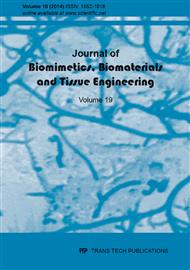[1]
A. Ascenzi, A. Benvenuti, Orientation of collagen fibers at the boundary between two successive osteonic lamellae and its mechanical interpretation, J. of Biomech. 19 (1986) 455 – 463.
DOI: 10.1016/0021-9290(86)90022-9
Google Scholar
[2]
V. Cane, G. Marotti, G. Volpi, D. Zaffe, S. Palazzini, F. Remaggi, M.A. Muglia, Size and density of osteocyte lacunae in different regions of long bones, Calcified Tissue Int. 34 (1982) 558 – 563.
DOI: 10.1007/bf02411304
Google Scholar
[3]
E.B. Garner, R. Lakes, T. Lee, C. Swan, R. Brand, Viscoelastic dissipation in compact bone: Implications for stress-induced fluid flow in bone, J. Biomech. Eng. 122 (2000) 166 – 172.
DOI: 10.1115/1.429638
Google Scholar
[4]
J.F. Mano, Viscoelastic properties of bone: Mechanical spectroscopy studies on a chicken model, Mat. Sci. Eng. C, 25 (2005) 145 – 152.
Google Scholar
[5]
R. Schaller, S. Barrault, Ph. Zysset, Mechanical spectroscopy of bovine compact bone, Mat. Sci. Eng. A, 370 (2004) 569 – 574.
DOI: 10.1016/j.msea.2003.08.107
Google Scholar
[6]
M.F. Ashby, L.J. Gibson, Cellular solids structure and properties. Cambridge University Press, Cambridge, (1997).
Google Scholar
[7]
J.S. Yerramshetty, O. Akkus, The associations between mineral crystallinity and the mechanical properties of human cortical bone, Bone, 42 (2008) 476 – 482.
DOI: 10.1016/j.bone.2007.12.001
Google Scholar
[8]
R. Schaller, G. Fantozzi, G. Gremaud, Mechanical Spectroscopy, Trans. Tech. Publications Ltd., Switzerland, (2001).
Google Scholar
[9]
B.J. Lazan, Damping of materials and members in structural mechanics, Pergamon, London, (1968).
Google Scholar
[10]
T. Wang, Z. Feng, Dynamic mechanical properties of cortical bone: The effect of mineral content, Mater. Lett. 59 (2005) 2277 – 2280.
DOI: 10.1016/j.matlet.2004.08.048
Google Scholar
[11]
N.W. Tschoegel, The phenomenological theory of linear viscoelastic behaivour, Springer-Verlag, Berlin, (1989).
Google Scholar
[12]
O.A. Lambri, A Review on the problem of measuring non-linear damping and the obtainment of intrinsic damping, in: Walgraef, D.; Martínez-Mardones, J. and Wörner, C. H. (Eds. ), Materials Instabilities, World Scientific Publishing Co. Pte. Ltd., 2000, p.249.
DOI: 10.1142/9789812793317_0005
Google Scholar
[13]
L.M. Salvatierra, O.A. Lambri, C.L. Matteo, P.A. Sorichetti, C.A. Celauro, R.E. Bolmaro, Growing of crystalline zones in EPDM irradiated with a low neutron flux, Nucl. Instrum. Meth. B, 225 (2004) 297 – 304.
DOI: 10.1016/j.nimb.2004.04.166
Google Scholar
[14]
O.A. Lambri, L.M. Salvatierra, F.A. Sánchez, C.L. Matteo, P.A. Sorichetti, C.A. Celauro, Crystal growth in EPDM by chemi-crystallisation as a function of the neutron irradiation dose and flux level, Nucl. Instrum. Meth. B, 237 (2005) 550 – 562.
DOI: 10.1016/j.nimb.2005.03.012
Google Scholar
[15]
O.A. Lambri, J.A. García, W. Riehemann, J.A. Cano, G.I. Zelada-Lambri, F. Plazaola, Dislocation movement in WE43 magnesium alloy during recovery and recrystallisation, Mater. T. JIM. 52 (2011) 1016 – 1025.
DOI: 10.2320/matertrans.m2010374
Google Scholar
[16]
O.A. Lambri, W. Riehemann, Z. Trojanová, Mechanical spectroscopy of commercial AZ91 magnesium alloy, Scripta Mater. 45 (2001) 1365 – 1371.
DOI: 10.1016/s1359-6462(01)01171-x
Google Scholar
[17]
O.A. Lambri, G.I. Zelada-Lambri, G.J. Cuello, P.B. Bozzano, J.A. García, Study of the temperature evolution of defect agglomerates in neutron irradiated molybdenum single crystals, J. Nucl. Mater. 385 (2009) 552 – 558.
DOI: 10.1016/j.jnucmat.2008.12.312
Google Scholar
[18]
T. Mura, Micromechanics of defects in solids, Martinus Nijhoff Publishers, New York, (1987).
Google Scholar
[19]
O.A. Lambri, W. Riehemann, Damping due to incoherent precipitates in commercial QE22 magnesium alloy, Scripta Mater. 52 (2005) 93 – 97.
DOI: 10.1016/j.scriptamat.2004.09.021
Google Scholar
[20]
G.I. Zelada-Lambri, O.A. Lambri, G.H. Rubiolo, Amplitude dependent damping in austenitic stainless steels 316H and 304H. Its relation with the microstructure, J. Nucl. Mater. 273 (1999) 248 – 256.
DOI: 10.1016/s0022-3115(99)00070-7
Google Scholar
[21]
R.R. Mocellini, O.A. Lambri, C.L. Matteo, J.A. García, G.I. Zelada-Lambri, P.A. Sorichetti, F. Plazaola, A. Rodríguez-Garraza, F.A. Sánchez, Elastic misfit in two-phase polymer, Polymer, 50 (2009) 4696 – 4705.
DOI: 10.1016/j.polymer.2009.07.037
Google Scholar
[22]
O.A. Lambri, F. Plazaola, E. Axpe, R.R. Mocellini, G.I. Zelada-Lambri, J.A. García, C.L. Matteo, P.A. Sorichetti, Modification of the mesoscopic structure in neutron irradiated EPDM viewed through positron annihilation spectroscopy and dynamic mechanical analysis, Nucl. Instrum. Meth. B, 269 (2011).
DOI: 10.1016/j.nimb.2010.11.095
Google Scholar
[23]
M.L. Lambri, J.I. Pérez-Landazábal, V. Recarte, F. Tarditti, O.A. Lambri, Effect of the mesostructure on the mechanical dynamical behaviour in cancellous bones, Acta Microscópica, 22 (2013) 26 – 31.
DOI: 10.4028/www.scientific.net/jbbte.19.87
Google Scholar
[24]
A.S. Nowick, B.S. Berry, Anelastic Relaxation in Crystalline Solids, Academic Press, New York, (1972).
Google Scholar
[25]
O.A. Lambri, A.L. Peñaloza, A.V. Morón Alcain, M.L. Ortiz, F.C. Lucca, Mecahnical dynamical spectroscopy in Cu-Li alloys produced by electrodeposition, Mat. Sci. Eng. A, 212 (1996) 108 – 118.
DOI: 10.1016/0921-5093(96)10178-7
Google Scholar
[26]
I.M. Ward, Mechanical properties of solid polymers, John Wiley & Sons, New York, (1990).
Google Scholar
[27]
V. Uskokovic, N. Ignjatovic, N. Petranovic, Synthesis and characterization of hydroxyapatite-collagen biocomposite materials, Mater. Sci. Forum, 413 (2003) 269 – 274.
Google Scholar
[28]
J. Benedito, J.A. Carcel, C. Rosello, A. Mulet, Composition assessment of raw meat mixtures using ultrasonics, Meat Sci. 57 (2001) 365 – 370.
DOI: 10.1016/s0309-1740(00)00113-3
Google Scholar
[29]
J.A. Babor, J. Ibarz, Modern general chemistry, Marín, Barcelona, (1965).
Google Scholar
[30]
B.D. Hames, N.M. Hooper, Instant notes biochemistry, Second edition, BIOS Scientific Publishers, England, (2000).
Google Scholar
[31]
J. Yamashita, B.R. Furman, H. R Rawls, X. Wang, C.M. Agrawal, The use of dynamic analysis to assess the viscoelastic properties of human cortical bone, J. Biomed. Mater. Res. 58 (2001) 47 – 53.
DOI: 10.1002/1097-4636(2001)58:1<47::aid-jbm70>3.0.co;2-u
Google Scholar
[32]
Y. Dekhtyar, A. Gamza, A. Tatarinov, H. Jansons, Electron and mechanical properties of bone during heating, evaluated by exoelectron emission and ultrasound, Biomaterials 16 (1995) 861 – 863.
DOI: 10.1016/0142-9612(95)94148-e
Google Scholar
[33]
K.O. Honikel, Reference methods for the assessment of physical characteristics of meat, Meat Sci. 49 (1998) 447 – 457.
DOI: 10.1016/s0309-1740(98)00034-5
Google Scholar


